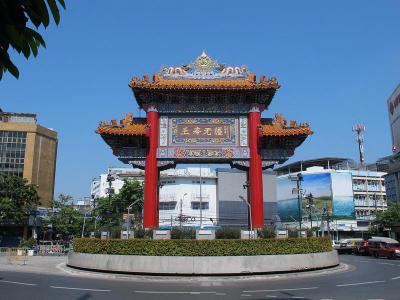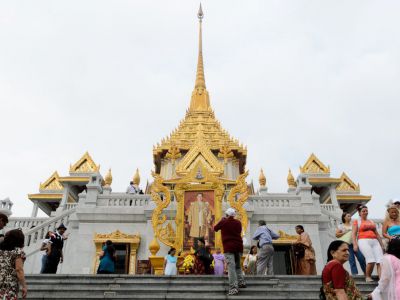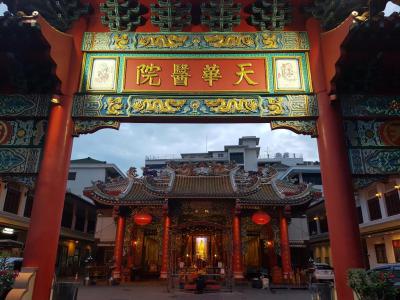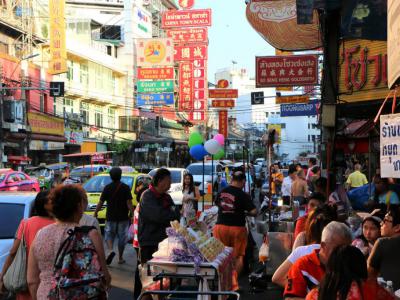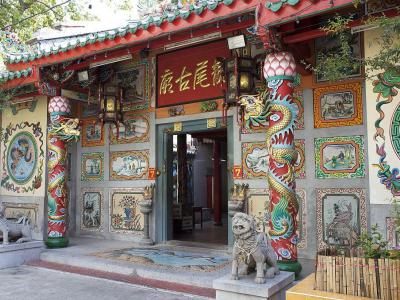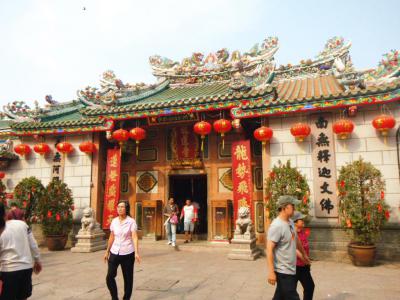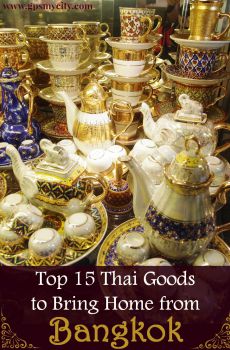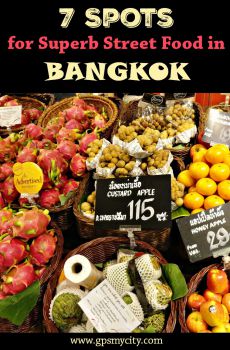
Chinatown Walking Tour (Self Guided), Bangkok
Bangkok's Chinatown is one of the largest Chinatowns in the world. Founded in 1782, the core of it lies along Yaowarat Road, which serves as the main artery and sometimes lends its name to the whole area.
The district has been the center for trading by the Thai Chinese community for almost 200 years, progressively evolving from a vast wilderness outside the city walls to a major commercial and cultural hub throughout the late 19th-early 20th centuries. Presently, despite gradual assimilation of the Chinese population's into Thai society, Chinatown still remains a home base for Chinese cuisine, crafts and religion.
Yaowarat Road, well known for its variety of foodstuffs, at night turns into a large "food street", stretching for 1.5 kilometers, starting from the Odeon Circle near Wat Traimit, or Temple of Golden Buddha. Definitely one of the best places to eat in Bangkok, this bustling thoroughfare never sleeps, filled with a vibrant mix of colours, scents and flavours coming from the roadside restaurants and all-day markets, and surrounded by neon lights after sunset.
Venturing a little further from the main road, you escape the crowds and discover a totally different world of daily life in its purest form. The latter, in part, is manifested in the hidden shrines, tucked away from the chaos, such as the Leng Buai Ia and Wat Mangkon Kamalawat (Dragon Lotus Temple).
If you wish to explore one of Bangkok's brightest, most vibrant and interesting districts in its entirety, complete with its top tourist spots, amazing temples and colonial-style architecture, the best way to do it is on foot and with the help of this self-guided tour of Chinatown. Just don't forget to take small bills and an umbrella while embarking on it!
The district has been the center for trading by the Thai Chinese community for almost 200 years, progressively evolving from a vast wilderness outside the city walls to a major commercial and cultural hub throughout the late 19th-early 20th centuries. Presently, despite gradual assimilation of the Chinese population's into Thai society, Chinatown still remains a home base for Chinese cuisine, crafts and religion.
Yaowarat Road, well known for its variety of foodstuffs, at night turns into a large "food street", stretching for 1.5 kilometers, starting from the Odeon Circle near Wat Traimit, or Temple of Golden Buddha. Definitely one of the best places to eat in Bangkok, this bustling thoroughfare never sleeps, filled with a vibrant mix of colours, scents and flavours coming from the roadside restaurants and all-day markets, and surrounded by neon lights after sunset.
Venturing a little further from the main road, you escape the crowds and discover a totally different world of daily life in its purest form. The latter, in part, is manifested in the hidden shrines, tucked away from the chaos, such as the Leng Buai Ia and Wat Mangkon Kamalawat (Dragon Lotus Temple).
If you wish to explore one of Bangkok's brightest, most vibrant and interesting districts in its entirety, complete with its top tourist spots, amazing temples and colonial-style architecture, the best way to do it is on foot and with the help of this self-guided tour of Chinatown. Just don't forget to take small bills and an umbrella while embarking on it!
How it works: Download the app "GPSmyCity: Walks in 1K+ Cities" from Apple App Store or Google Play Store to your mobile phone or tablet. The app turns your mobile device into a personal tour guide and its built-in GPS navigation functions guide you from one tour stop to next. The app works offline, so no data plan is needed when traveling abroad.
Chinatown Walking Tour Map
Guide Name: Chinatown Walking Tour
Guide Location: Thailand » Bangkok (See other walking tours in Bangkok)
Guide Type: Self-guided Walking Tour (Sightseeing)
# of Attractions: 7
Tour Duration: 1 Hour(s)
Travel Distance: 1.5 Km or 0.9 Miles
Author: valery
Sight(s) Featured in This Guide:
Guide Location: Thailand » Bangkok (See other walking tours in Bangkok)
Guide Type: Self-guided Walking Tour (Sightseeing)
# of Attractions: 7
Tour Duration: 1 Hour(s)
Travel Distance: 1.5 Km or 0.9 Miles
Author: valery
Sight(s) Featured in This Guide:
- Chinatown Gate
- Wat Traimit (Temple of the Golden Buddha)
- Kuan Yim Shrine
- Yaowarat Road
- Talat Kao Market
- Leng Buai Ia Shrine
- Wat Mangkon Kamalawat (Dragon Lotus Temple)
1) Chinatown Gate (must see)
Built in 1999 as part of the celebrations of King Bhumibol Adulyadej's 72's birthday, the Chinatown Gate is sometimes called "Odean Gate" after the Odean cinema that once stood nearby. The words on the gate say "Sheng Shou Wu Jiang", translated as "Long Live the King". During Chinese New Year celebrations, the gate becomes the center of activities where people make their offerings.
Chinatown Gate is the entrance to many sites, a brief description of which is given below:
- Wat Traimit, a small temple, home to the world's largest five-ton-plus solid gold Buddha image;
- Li Thi Miew Temple, one of the more open and accessible of many Chinese temples in Chinatown;
- Wat Kanikaphon, a small temple with some interesting details, founded by a former Madame who owned a brothel;
- Tien Fa Charity, a small clinic run by a charitable foundation, with a large chapel to the goddess Ming in its courtyard;
- Sampaeng Lane, Chinatown's original main street, now a small narrow alley crowded with shops selling mostly inexpensive household items and a very old Chinese pharmacy – definitely worth a look;
- Wat Mangkon Kamalawat, the Chinese-Buddhist temple – a center of festivities during important festivals such as the Chinese New Year and the vegetarian festival;
- Phahurat Market, a small community center for Sikhs and other immigrants from the subcontinent, home to a large number of fabric and wedding stalls;
- Wat Chakrawat, one of Bangkok's three biggest monasteries, housing some very unusual buildings and a few crocodiles!;
- The Old Siam, a shopping center where you will find tourist-friendly western and Thai restaurants and fast food outlets.
In short, Chinatown Gate gives you the visa to enter into a whole new world to explore and enjoy!
Tip:
Plan ahead so you can visit the top spots and leave room in your stomach for the unexpected – but be sure to eat where the locals are queueing.
Chinatown Gate is the entrance to many sites, a brief description of which is given below:
- Wat Traimit, a small temple, home to the world's largest five-ton-plus solid gold Buddha image;
- Li Thi Miew Temple, one of the more open and accessible of many Chinese temples in Chinatown;
- Wat Kanikaphon, a small temple with some interesting details, founded by a former Madame who owned a brothel;
- Tien Fa Charity, a small clinic run by a charitable foundation, with a large chapel to the goddess Ming in its courtyard;
- Sampaeng Lane, Chinatown's original main street, now a small narrow alley crowded with shops selling mostly inexpensive household items and a very old Chinese pharmacy – definitely worth a look;
- Wat Mangkon Kamalawat, the Chinese-Buddhist temple – a center of festivities during important festivals such as the Chinese New Year and the vegetarian festival;
- Phahurat Market, a small community center for Sikhs and other immigrants from the subcontinent, home to a large number of fabric and wedding stalls;
- Wat Chakrawat, one of Bangkok's three biggest monasteries, housing some very unusual buildings and a few crocodiles!;
- The Old Siam, a shopping center where you will find tourist-friendly western and Thai restaurants and fast food outlets.
In short, Chinatown Gate gives you the visa to enter into a whole new world to explore and enjoy!
Tip:
Plan ahead so you can visit the top spots and leave room in your stomach for the unexpected – but be sure to eat where the locals are queueing.
2) Wat Traimit (Temple of the Golden Buddha) (must see)
On the eastern edge of Chinatown, the Wat Traimit Witthayaram is home to the world's largest solid gold Buddha – 3 meters (9.8 feet) tall and weighing 5.5 tonnes – and is consequently known also as the Temple of the Golden Buddha.
Worth millions of dollars at today's gold price, the Golden Buddha was cast sometime in the 13th century and is an excellent example of the gracious Sukhothai style. This statue has such a bright, reflective surface that its edges seem to disappear, and it shines with such richness and purity that everyone is inspired by it. At one point, it was covered in plaster and colored glass – presumably to disguise it from Burmese invaders – and remained like this for nearly two centuries. Only in 1955, when an accident while moving it caused the surface to crack off, was its true nature revealed.
The Golden Buddha is now installed at the highest level of Wat Traimit, with the plaster pieces that once hid it from looters being displayed in a case to the left. The gold, the gems, the mosaic patterns all combine to make a spectacular sight.
Few of the Thai temples also have two quite interesting museums incorporated – this one does! The 2nd-floor exhibits cover the history of Bangkok's Chinese community and the 3rd-floor exhibits allow you to learn more about the story of the Golden Buddha itself.
Tip:
It will cost you 40 THB to get into the temple and another 100 THB to get into the museums.
This is a sacred place, so your arms and legs must be covered. Be prepared to remove your shoes.
Worth millions of dollars at today's gold price, the Golden Buddha was cast sometime in the 13th century and is an excellent example of the gracious Sukhothai style. This statue has such a bright, reflective surface that its edges seem to disappear, and it shines with such richness and purity that everyone is inspired by it. At one point, it was covered in plaster and colored glass – presumably to disguise it from Burmese invaders – and remained like this for nearly two centuries. Only in 1955, when an accident while moving it caused the surface to crack off, was its true nature revealed.
The Golden Buddha is now installed at the highest level of Wat Traimit, with the plaster pieces that once hid it from looters being displayed in a case to the left. The gold, the gems, the mosaic patterns all combine to make a spectacular sight.
Few of the Thai temples also have two quite interesting museums incorporated – this one does! The 2nd-floor exhibits cover the history of Bangkok's Chinese community and the 3rd-floor exhibits allow you to learn more about the story of the Golden Buddha itself.
Tip:
It will cost you 40 THB to get into the temple and another 100 THB to get into the museums.
This is a sacred place, so your arms and legs must be covered. Be prepared to remove your shoes.
3) Kuan Yim Shrine
The colorful Kuan Yim shrine was established during the reign of King Chulalongkorn (Rama V), in 1903 and completed in 1905, as part of the Thian Fa Foundation. The Foundation itself was set up, as a charitable organization, in 1902 by the Chinese immigrants in Bangkok. The buildings surrounding the shrine are a hospital.
The latter, originally, was to provide free traditional Chinese medical care to the poor and homeless, while the shrine took care of the spiritual part of the healing process. Today, the hospital delivers both traditional Chinese and conventional modern treatments.
The temple's patron, Kuan or Guan Yim, is the Chinese goddess of mercy. Also known in Thailand as Bodhisattva Phra Avalokitesuan, she embodies love, kindness, compassion and forgiveness, and as such has been worshiped for almost 3,000 years. The beautiful statue of Kuan Yim displayed at the temple, carved from teak and painted gold, is about 900 years old. It dates all the way back to the Tang dynasty and was imported from China in 1958. With her right hand Kuan Yim makes the Varada mudra, the gesture of charity and offering.
The temple walls are painted with colorful, Chinese-style murals depicting various deities. This is one of the most popular shrines in the area, being particularly busy on Chinese holidays (e.g. New Year). Locals come here to pray for blessings in fertility, success (e.g. students in time of exams), health (those visiting patients at the hospital) and happiness. Worshipers bring flowers, burn candles or light incense sticks that they put in a bowl filled with sand.
The shrine is open daily until late hours. The atmosphere is usually quiet and serene. NOTE: make sure to take off your shoes before entering.
The latter, originally, was to provide free traditional Chinese medical care to the poor and homeless, while the shrine took care of the spiritual part of the healing process. Today, the hospital delivers both traditional Chinese and conventional modern treatments.
The temple's patron, Kuan or Guan Yim, is the Chinese goddess of mercy. Also known in Thailand as Bodhisattva Phra Avalokitesuan, she embodies love, kindness, compassion and forgiveness, and as such has been worshiped for almost 3,000 years. The beautiful statue of Kuan Yim displayed at the temple, carved from teak and painted gold, is about 900 years old. It dates all the way back to the Tang dynasty and was imported from China in 1958. With her right hand Kuan Yim makes the Varada mudra, the gesture of charity and offering.
The temple walls are painted with colorful, Chinese-style murals depicting various deities. This is one of the most popular shrines in the area, being particularly busy on Chinese holidays (e.g. New Year). Locals come here to pray for blessings in fertility, success (e.g. students in time of exams), health (those visiting patients at the hospital) and happiness. Worshipers bring flowers, burn candles or light incense sticks that they put in a bowl filled with sand.
The shrine is open daily until late hours. The atmosphere is usually quiet and serene. NOTE: make sure to take off your shoes before entering.
4) Yaowarat Road
Once a poultry farm, this one-way street is now the heart of Chinatown's (and Thailand's) gold trade, with over 100 dealers of the precious metal, their shops painted gold and bright red for good luck and flaunting glittering displays of bracelets and necklaces. More often than not, gold is sold here by the bàht (equivalent to 15 grams, or about half an ounce), with daily prices scrawled on the windows.
Chaotic as it may seem, Yaowarat Road serves as the central artery to a network of street markets twisting down side alleys, and as you stroll further toward the intersection of Ratchawong Road, you will get a good feel for the pulse, energy and of course the smells of Chinatown.
There are always plenty of things to satisfy tourists' tastes – from dried fruit and nuts to chintzy talismans and accouterments for Chinese festivals. Each evening the street gets even busier as food stalls and vendors occupy every inch of space available, while the forest of neon signs makes it look in places much like a Hong Kong thoroughfare.
Chaotic as it may seem, Yaowarat Road serves as the central artery to a network of street markets twisting down side alleys, and as you stroll further toward the intersection of Ratchawong Road, you will get a good feel for the pulse, energy and of course the smells of Chinatown.
There are always plenty of things to satisfy tourists' tastes – from dried fruit and nuts to chintzy talismans and accouterments for Chinese festivals. Each evening the street gets even busier as food stalls and vendors occupy every inch of space available, while the forest of neon signs makes it look in places much like a Hong Kong thoroughfare.
5) Talat Kao Market
This Thai-Chinese trading community is Bangkok's oldest market, continuously operating since the beginning of the King Rama V reign (1868 – 1910). The wooden houses lining the alley vividly reflect the old times.
The name originates from a 9-room house that was reportedly built by certain Mr. Hong who moved here after selling off his rafting boat parking and established a river-based trading post in the area. He called the market "Talat Kao Hong" after his house's original name.
Not long after, he built a 5-story watchtower – 4 meters wide by 4 meters long – designated to prevent theft and killings in the neighborhood, widespread at the time. During Work World II, the tower served as an observation post against enemy bombers, signaling air-raid alarms. Presently, this is one of the key local landmarks.
The alley-way is quite small – not longer than two blocks; and narrow – in some places there is barely enough space for two people to squeeze past one another, and that’s when no one stops to make a purchase. Add to this an occasional motor bike making deliveries and it can get very cramped, particularly on holidays; so one should always be prepared for a bit of jostling.
The market is full of fresh seafood of all varieties, including fish, shrimp, prawns, and some things that you might not recognize, such as sea cucumbers. There’s also many vendors with dried foods such as red dates, dried persimmons, dried fish and dried fish stomach. Of course, there is also prepared food: from the delectable kanom krok (grilled coconut-rice hotcakes) to "dim sum" (tender bite-sized morsels), curries, traditional noodles topped with sauce, and other authentic Thai or Chinese dishes and desserts like Chan Ub or Pia.
And since it’s a Chinese market, you will find succulent roast duck and duck noodles too, plus, on festive occasions, whole roast pigs being sold.
The name originates from a 9-room house that was reportedly built by certain Mr. Hong who moved here after selling off his rafting boat parking and established a river-based trading post in the area. He called the market "Talat Kao Hong" after his house's original name.
Not long after, he built a 5-story watchtower – 4 meters wide by 4 meters long – designated to prevent theft and killings in the neighborhood, widespread at the time. During Work World II, the tower served as an observation post against enemy bombers, signaling air-raid alarms. Presently, this is one of the key local landmarks.
The alley-way is quite small – not longer than two blocks; and narrow – in some places there is barely enough space for two people to squeeze past one another, and that’s when no one stops to make a purchase. Add to this an occasional motor bike making deliveries and it can get very cramped, particularly on holidays; so one should always be prepared for a bit of jostling.
The market is full of fresh seafood of all varieties, including fish, shrimp, prawns, and some things that you might not recognize, such as sea cucumbers. There’s also many vendors with dried foods such as red dates, dried persimmons, dried fish and dried fish stomach. Of course, there is also prepared food: from the delectable kanom krok (grilled coconut-rice hotcakes) to "dim sum" (tender bite-sized morsels), curries, traditional noodles topped with sauce, and other authentic Thai or Chinese dishes and desserts like Chan Ub or Pia.
And since it’s a Chinese market, you will find succulent roast duck and duck noodles too, plus, on festive occasions, whole roast pigs being sold.
6) Leng Buai Ia Shrine
Hidden in the narrow alleys of Bangkok's Chinatown, this Chinese shrine is considered to be the oldest in Thailand, based on a plaque contained inside with an inscription stating that it was built in 1658, during the Ayutthaya period. Thought to have originally been a Teochew-style shrine, it would have been used by Chinese businessmen aiming to improve the prosperity of their businesses and to establish social connections.
Small and very colorful, the shrine has a roof made of glazed tiles, adorned with two ceramic-clad dragons. The central altar is dedicated to Leng Buai Ia and his wife, while to the left and right there are altars to the deity Gong Wu (Guan Yu) and the Queen of Heaven, Tianhou, respectively.
Near the entrance is an ancient bell attributed to the Daoguang Emperor, towards the end of the Qing dynasty. Other items of interest include three plaques from the reign of the Kangxi Emperor in the Qing dynasty, a bell inscribed with the name of Choen Thai Chue, and a container for incense sticks given as a gift from King Chulalongkorn (Rama V).
Small and very colorful, the shrine has a roof made of glazed tiles, adorned with two ceramic-clad dragons. The central altar is dedicated to Leng Buai Ia and his wife, while to the left and right there are altars to the deity Gong Wu (Guan Yu) and the Queen of Heaven, Tianhou, respectively.
Near the entrance is an ancient bell attributed to the Daoguang Emperor, towards the end of the Qing dynasty. Other items of interest include three plaques from the reign of the Kangxi Emperor in the Qing dynasty, a bell inscribed with the name of Choen Thai Chue, and a container for incense sticks given as a gift from King Chulalongkorn (Rama V).
7) Wat Mangkon Kamalawat (Dragon Lotus Temple)
Previously, and still often referred to as Wat Leng Noei Yi, this site stands as Bangkok's largest and most significant Chinese Buddhist temple. Its present name, Wat Mangkon Kamalawat, meaning "Dragon Lotus Temple," was bestowed upon it by King Chulalongkorn (Rama V) at a later date.
Established as a Mahayana Buddhist shrine around 1871 or 1872 (sources vary), this temple showcases a classic Chinese architectural style, characterized by its sweeping tiled roofs adorned with animal and floral patterns, notably the iconic Chinese dragons. Inside the ordination hall (ubosot), you'll find the temple's principal gold-colored Buddha image, featuring a blend of Thai and Chinese artistic elements, complemented by an altar for religious ceremonies.
As you approach the sermon hall (viharn) through the main entrance, you'll encounter imposing statues of the four guardians of the world, known as the Chatulokkaban, attired in warrior attire – two on either side. Throughout the temple grounds, various shrines pay homage to a diverse array of Buddhist, Taoist, and Confucian deities and religious figures.
Towards the rear of the temple complex, three pavilions stand dedicated to specific figures: one to Guan Yin, the Chinese goddess (or bodhisattva) of compassion; another to the temple's founder, Phra Archan Chin Wang Samathiwat; and a third to the saint Lak Chao. Nearby, a gallery houses gilded Buddha images posed in the double Abhaya Mudra position.
The courtyard in front of the main temple structures hosts several additional shrines, including a furnace for the ritual burning of paper money and other offerings to honor ancestors. Worshipers can often be seen here lighting incense sticks and maintaining the perpetual altar lamps.
Throughout the year, the temple hosts various festivities, including the celebration of Chinese New Year (usually in January or February) and the Chinese vegetarian festival (typically in September or October).
Established as a Mahayana Buddhist shrine around 1871 or 1872 (sources vary), this temple showcases a classic Chinese architectural style, characterized by its sweeping tiled roofs adorned with animal and floral patterns, notably the iconic Chinese dragons. Inside the ordination hall (ubosot), you'll find the temple's principal gold-colored Buddha image, featuring a blend of Thai and Chinese artistic elements, complemented by an altar for religious ceremonies.
As you approach the sermon hall (viharn) through the main entrance, you'll encounter imposing statues of the four guardians of the world, known as the Chatulokkaban, attired in warrior attire – two on either side. Throughout the temple grounds, various shrines pay homage to a diverse array of Buddhist, Taoist, and Confucian deities and religious figures.
Towards the rear of the temple complex, three pavilions stand dedicated to specific figures: one to Guan Yin, the Chinese goddess (or bodhisattva) of compassion; another to the temple's founder, Phra Archan Chin Wang Samathiwat; and a third to the saint Lak Chao. Nearby, a gallery houses gilded Buddha images posed in the double Abhaya Mudra position.
The courtyard in front of the main temple structures hosts several additional shrines, including a furnace for the ritual burning of paper money and other offerings to honor ancestors. Worshipers can often be seen here lighting incense sticks and maintaining the perpetual altar lamps.
Throughout the year, the temple hosts various festivities, including the celebration of Chinese New Year (usually in January or February) and the Chinese vegetarian festival (typically in September or October).
Walking Tours in Bangkok, Thailand
Create Your Own Walk in Bangkok
Creating your own self-guided walk in Bangkok is easy and fun. Choose the city attractions that you want to see and a walk route map will be created just for you. You can even set your hotel as the start point of the walk.
Bangkok Old City Walk
The Thai capital Bangkok emerged in the 15th century as a small trading post in the Chao Phraya River delta. The origin of the name “Bangkok” is unclear and was likely a colloquial adopted by foreigners, in which Bang is the Thai word for “village on a stream” and Ko means “island”, referring to the city's watery landscape. Another opinion is that it may be shortened from Bang... view more
Tour Duration: 2 Hour(s)
Travel Distance: 2.8 Km or 1.7 Miles
Tour Duration: 2 Hour(s)
Travel Distance: 2.8 Km or 1.7 Miles
Food Walk
There aren't many cities out there, if any, beside the Thai capital to be just as voracious and passionate about eating! Food in Bangkok is a key aspect of daily life, attesting to which are the numerous eateries all over the city. And what's more, regardless of where you have it, be it a scrumptious street food stall or a fancy restaurant, the local food never fails to impress.
... view more
Tour Duration: 1 Hour(s)
Travel Distance: 2.8 Km or 1.7 Miles
... view more
Tour Duration: 1 Hour(s)
Travel Distance: 2.8 Km or 1.7 Miles
Wats and Temples of Bangkok
The “City of Angels” – Bangkok – is a home to over 400 temples. Known locally as "wats", some of them are massive complexes, quite famous and attracting thousands of tourists every day, while others are smaller and lesser-known, located far down the tiny "sois" (side streets), well out of tourist traffic. Still, all these shrines equally form an integral part of the... view more
Tour Duration: 2 Hour(s)
Travel Distance: 3.4 Km or 2.1 Miles
Tour Duration: 2 Hour(s)
Travel Distance: 3.4 Km or 2.1 Miles
Flower Market to Chinatown
One of the shopping capitals of the world, Bangkok is a city where you can buy almost anything, provided you know where to find it. And if shopping spree is high on your agenda, then the local markets are the best place to go.
Vibrant atmosphere, smiling faces, plus the staggering variety of unique things on offer, including wealth of delicious street food and snacks – there's nothing... view more
Tour Duration: 1 Hour(s)
Travel Distance: 2.3 Km or 1.4 Miles
Vibrant atmosphere, smiling faces, plus the staggering variety of unique things on offer, including wealth of delicious street food and snacks – there's nothing... view more
Tour Duration: 1 Hour(s)
Travel Distance: 2.3 Km or 1.4 Miles
Useful Travel Guides for Planning Your Trip
Top 15 Things to Buy in Bangkok
Well-made, local products not only remind people of the trip they've had, but also make great gifts to bring home to family and friends. Following is the list of original and representative of Bangkok local specialties that you might wish to consider as a memorable...
7 Places in Bangkok for Superb Street Food
Eating is huge in Bangkok, and luckily for the famished, you won't be that way for long, regardless of the hour. You can find conglomerations of vendors selling five-star fast food (in the you-won't-have-to-wait-long-to-enjoy-it sense, not McDonald's style) for under 100 baht (roughly...
The Most Popular Cities
/ view all
